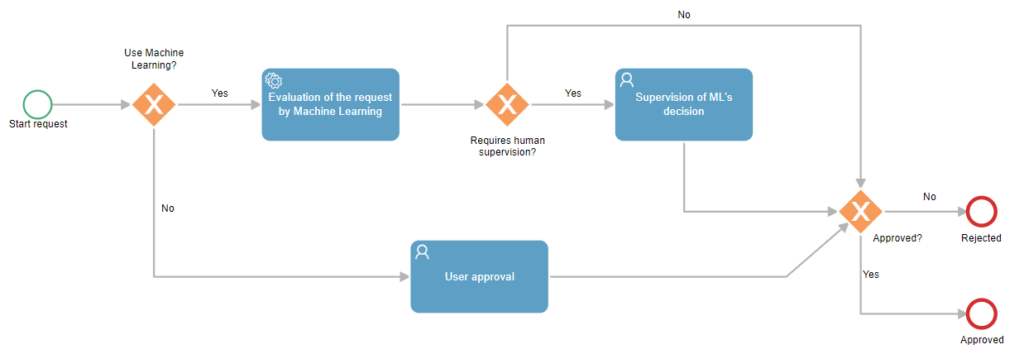Machine learning in business processes with BPM are revolutionizing the way we work. The inclusion of technologies such as ChatGPT has made AI an indispensable tool in many professions. While it is intuitive to think that AI can also help optimize business processes, many organizations struggle to begin its adoption.
Among the main challenges organizations face are:
- Insufficient data to create effective AI solutions.
- Lack of trust in decisions or predictions made by AI.
- Changes in employees’ work processes.
However, having automated processes with a BPM tool allows for the natural and controlled adoption of AI. One way to do this could be through the adoption of ML models for automatic approvals.
In this article, we will explain some strategies for incorporating Machine Learning into business processes with BPM.
Why combine Machine Learning and BPM?
BPM tools allow for the gradual and controlled integration of machine learning models into processes. This is because it’s possible to define processes in such a way that people can supervise the decisions made by machine learning models. Once the results obtained are trustworthy, the process can be adjusted with simple changes so that human intervention is no longer necessary. If, for any reason, it’s necessary to go back, it can be done immediately without requiring programming efforts.
The following image shows how, by simply modifying the decision points of “Use Machine Learning?” and “Requires Human Supervision?”, the expected behavior can be achieved.

Additionally, business processes are an important source of information to train machine learning models. If a person has to approve a purchase request, they may see a form with amounts, a reason, the supplier, among other data. All that information, along with the decision made, can be used to train the machine learning model, which can learn patterns and generate predictions of decisions. In this way, BPM allows for constantly collecting information to improve ML algorithms, being able to learn from changes that occur in businesses.
Considerations when incorporating machine learning into business processes
There are some considerations to take into account when incorporating machine learning in business processes with BPM.
One of the most important factors to consider is the choice between more explanatory and less explanatory but more accurate algorithms. This decision may depend on the specific use case. For example, for a process in which a contact request is classified as spam or not spam, understanding what criteria was used to identify it as spam may not be as important, since the main focus is on achieving the highest possible accuracy. However, in decisions that determine whether to approve a bank loan or not, it may be necessary to be accountable and explain the reasons for the decision made.
On the other hand, it is important to consider possible biases that may arise in the algorithms. For example, in a personnel selection process of a software development company where a large part of the company are men, a machine learning model may consider that women are not as suitable for the organization as men. Therefore, it is necessary to ensure that these biases do not occur.
Strategies for incorporating Machine Learning into business processes.
Decisions recommendation
One of the most common ways to use machine learning in business processes is for decision recommendation. In this case, a pre-trained algorithm takes the entered data and makes a recommendation based on previous decisions. This recommendation can range from approval or rejection of a request to the selection of a specific action.
Since the final decision is made by a human and not by the algorithm, it is a low-risk way to start including artificial intelligence in decision-making. For these cases, it is useful for the algorithm to be explanatory so that the recipient of the recommendation can understand the reason for the decision.
For this strategy to be successful, it is important to make users aware that the responsibility for the decisions made lies with them and not with the algorithm.
The following is an example of a possible implementation of decision recommendation:

Decision-making
Another strategy to incorporate machine learning into business processes is decision-making.
There are several ways to incorporate decision-making with artificial intelligence into processes. To determine which one is most appropriate, you need to evaluate the criticality of the decision and the impact of errors. It is possible that in some cases, it is determined that it is not convenient for a decision to be made by artificial intelligence, while in others it is accepted with different conditions.
The following are some paths that can be taken for implementing decision-making with artificial intelligence:
Adding an additional evaluation for one of the possible decisions.
Often, the impact of having a false negative is different from having a false positive. For example, it may not have the same consequences for an organization if an algorithm decides to accept a candidate who actually lacks the skills or experience necessary to perform the job, which would be a false positive, compared to not identifying a suitable candidate for the position and discarding them incorrectly. While both behaviors are undesirable, hiring someone incorrectly can generate economic losses. To solve this, it is possible to perform only a manual evaluation in case the algorithm decides to accept the candidate, as shown in the following example:

Make an automatic decision if the confidence is higher than a certain threshold
Machine learning algorithms can provide information about the level of confidence they have in a decision, for example, indicating that a purchase request has a 60% chance of being approved. This aspect is fundamental because the level of confidence in a decision is not the same if there is a 60% or a 95% probability of it being correct.
It is possible to use this information to automate decision-making only if the algorithm has a confidence level above a certain threshold, such as 90%. Otherwise, the decision is evaluated manually. This can be seen in the process in the following image:

Make decisions by voting
There are BPM tools, such as Qflow, that allow for decision-making through voting. Decisions can be made by various Machine Learning models and people within the organization. This reduces the risk of an incorrect decision in the process.
The following image shows an example of a voting process:

Decision sampling
One way to evaluate the effectiveness of a model without requiring user actions is to randomly determine whether the decision should be reviewed or not. This has the additional benefit that manually validated decisions can be used to train and improve the model’s prediction for the future.
The following image shows what the process looks like:

Implementing preventive measures
The implementation of preventive processes is a scenario where artificial intelligence is very useful. An example of this is the identification of the risk of a student dropping out of a university. To do this, a periodic process can be carried out in which the level of dropout risk for each student is evaluated using machine learning. If the risk exceeds a set threshold, an investigation can be initiated to determine if additional measures are required.
This example can be seen in the following image:

Conclusion
In summary, incorporating machine learning in business processes with BPM can help optimize processes and improve the accuracy and speed of decision-making. Although there are challenges in adoption, the progressive and controlled integration of Machine Learning models into processes through BPM tools can reduce risks. In addition, business processes are an important source of information for training Machine Learning models.
It is expected that in the future, the combination of Machine Learning and BPM will continue to evolve, and organizations will increasingly adopt these tools to optimize their processes and improve efficiency.






